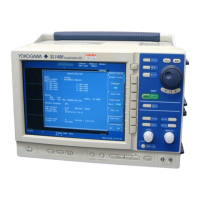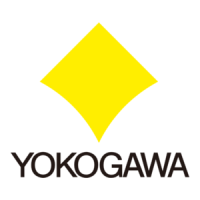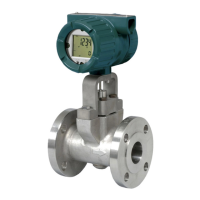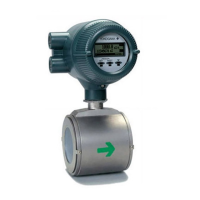7-14
IM 04P03B01-01E
Isolation
Item Specifications
Insulation resistance Each terminal to ground terminal: 20 MΩ or more (at 500 VDC)
Dielectric strength Power supply to ground terminal: 1500 VAC (50/60 Hz), 1 minute
Contact output terminal to ground terminal: 1500 VAC (50/60 Hz), 1 minute
Measuring input terminal to ground terminal: 1000 VAC (50/60 Hz), 1 minute
Between measuring input terminals: 1000 VAC (50/60 Hz), 1 minute (except for RTD input terminal)
Remote input terminal to ground terminal: 500 VDC, 1 minute
Grounding Grounding resistance: 100 Ω or less
Transport and Storage Conditions
Item Specifications
Ambient temperature –25 to 60°C
Ambient humidity 5 to 95%RH (no condensation)
Vibration 10 to 60 Hz, 4.9 m/s
2
maximum
Shock 392 m/s
2
maximum (in packaged condition)
Supported Standards
Item Specifications
CSA Certified by CSA22.2 No. 61010-1 (certified by NRTL/C), Installation category II
1
, Measurement
category II
2
, Pollution degree 2
3
* “US” (USA) and “C” (Canada) are indicated to the right and left of the CSA mark, respectively, to
show that NRTL is included.
CE
EMC EN61326(Emission: Class A, Immunity: Annex A)
EN61000-3-2
EN61000-3-3
EN55011 compliance Class A Group 1
Low voltage directive EN61010-1 compliance, Installation category II, Measurement category II, Pollution degree 2
C-Tick AS/NZS CISPR 11 compliance Class A Group 1
1 Installation category (overvoltage category) describes a number which defines a transient overvoltage condition. It implies
the regulation for impulse withstand voltage. “II” applies to electrical equipment which is supplied from the fixed installation
like a distribution board.
2 Applies to measuring circuits connected to low voltage installation, and electrical instruments supplied with power from fixed
equipment such as electric switchboards.
3 “Pollution degree” describes the degree to which a solid, liquid, or gas which deteriorates dielectric strength or surface
resistivity is adhering. “2” applies to normal indoor atmosphere. Normally, only non-conductive pollution occurs.
7.6 General Specifications

